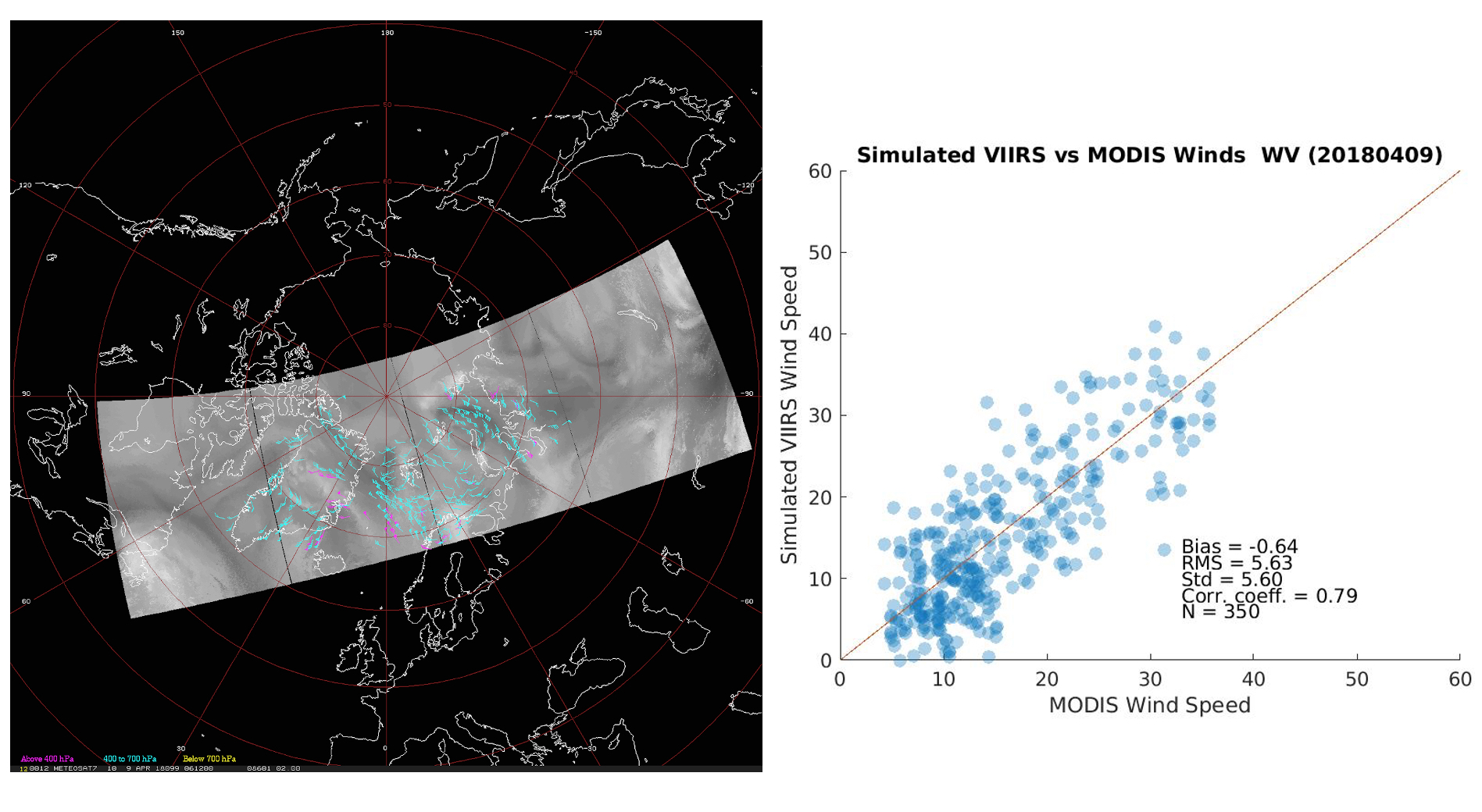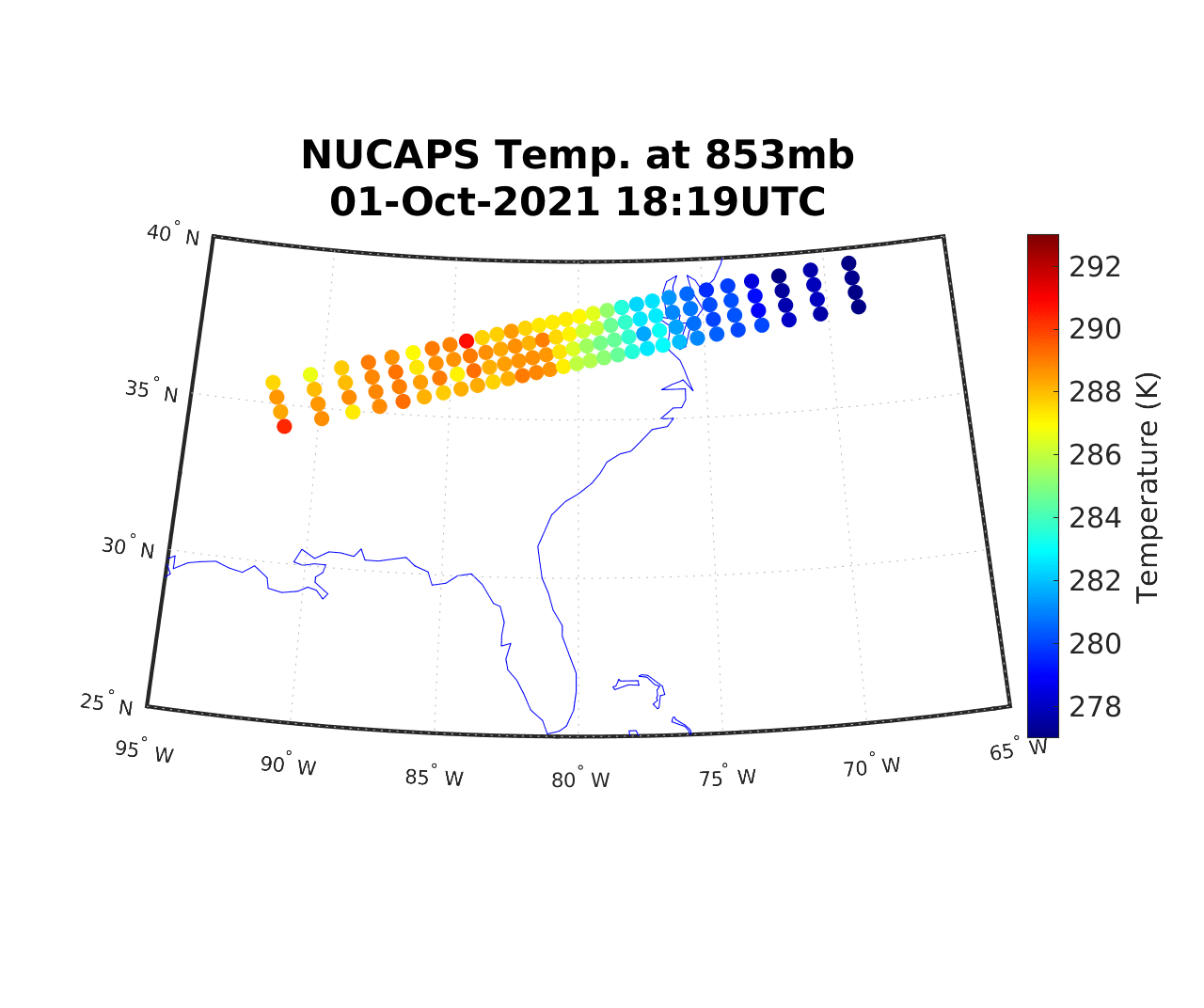
[ Archive ]

 |
CIMSS-NOAA Weekly Report [ Archive ] |
 |
CIMSS AND ASPB WEEKLY HIGHLIGHTS FOR THE WEEK ENDING OCTOBER 8, 2021
PRODUCTS AND APPLICATIONS:
Polar water vapor feature tracking with VIIRS/CrIS fusion: The ‘imager plus sounder’ (or imager/sounder) fusion method was originally developed to create the missing CO2 absorption band at 13.3 microns for VIIRS (Cross et al., 2013: doi: 10.1117/1.JRS.7.073473) to complement the existing IR window bands. Subsequently it was shown that any desired IR absorption band radiance could be constructed by merging high spatial resolution imager data with high spectral (but coarse spatial) resolution sounder data (Weisz et al., 2017: doi: 10.1117/1.JRS.11.036022). MODIS spectral bands are replicated in VIIRS/CrIS fusion with brightness temperatures within 0.5 C (1.0 C) for CO2 (H2O) sensitive bands. The addition of CO2 absorption bands (essential for cloud top height and phase, as well as temperature soundings) and water vapor absorption bands (important for tropospheric moisture determinations and polar water vapor feature tracking) enables the continuity of the data records established by HIRS and MODIS. Support from both NASA and NOAA has enabled a preliminary demonstration of good quality polar winds from feature tracking with SNPP VIIRS/CrIS fusion. When compared with those from Aqua MODIS for three polar overpasses on 9 April 2018, the figure below shows good coverage in vectors with comparable RMSE. Comparison with Aqua MODIS shows a bias of -0.6 m and RMSE of 5.6 m/s. For the most part, the fusion atmospheric motion vectors (AMVs) seem very reasonable as compared to the motion of the features and gradients. This suggests that the promise of water vapor winds can be realized with VIIRS/CrIS fusion. (D. Santek, CIMSS, 608-263-7410; W.P. Menzel, CIMSS, 608-263-4930)
 (Click image to enlarge)
(Click image to enlarge)
Figure: Polar VIIRS/CrIS fusion water vapor winds for 9 April 2018 and the statistical comparison with those from MODIS.
AWARDS AND RECOGNITION:
Scott Lindstrom - Unseen Hero: Congratulations to Scott Lindstrom, Cooperative Institute for Meteorological Satellite Studies (CIMSS), for being recognized with an Unseen Hero award for the 3rd Quarter of 2021. The award was given to Scott by the JPSS Program Office for "outstanding service and training opportunities created for JPSS data users." (J. Key, E/RA2, 608-263-2605, jeff.key@noaa.gov)
PUBLICATIONS:
Manuscript for Machine Learning-based ADT accepted to WAF: The manuscript "Investigation of Machine Learning using Satellite-Based Advanced Dvorak Technique Analysis Parameters to Estimate Tropical Cyclone Intensity" has been accepted for publication in the AMS journal Weather and Forecasting (DOI: 10.1175/WAF-D-20-0234.1). This new machine learning-based model has resulted in significant accuracy improvements to the Advanced Dvorak Technique (ADT), currently used globally at operational tropical cyclone forecast centers to estimate tropical cyclone intensity using satellite imagery. The new technique, called the AiDT (AI-enhanced ADT), ingests real-time ADT analysis parameters and produces a model-adjusted intensity estimate to augment the current ADT analysis. (T. Olander, CIMSS, 608-265-8005, T. Wimmers, CIMSS, 608-263-3294, C. Velden, CIMSS, 608-262-9168, J. Kossin, CIMSS, 608-265-5356)
WORKSHOPS, CONFERENCES, AND MEETINGS:
TRAINING AND EDUCATION:
MEDIA AND OUTREACH:
SSEC and CIMSS Scientists in the News: Scientists at the University of Wisconsin-Madison (UW) Space Science and Engineering Center (SSEC) and the Cooperative Institute for Meteorological Satellite Studies (CIMSS) provide expert interviews, imagery and case studies to promote science. This week: 1. SSEC Senior Scientist and Madison College Professor Matthew Lazzara was interviewed by The Washington Post for a story on record cold temperatures at the South Pole. Read more: https://www.washingtonpost.com/weather/2021/10/01/south-pole-coldest-winter-record/. BBC News (World) interviewed him for a follow-up story. Learn more: https://www.bbc.co.uk/programmes/p09y1n7g. 2. Working with SSEC Director Brad Pierce, UW-Madison graduate student Jerrold Acdan found his research niche at the intersection of climate change politics and chemistry – in atmospheric chemistry. SSEC News published this story: https://www.ssec.wisc.edu/news/articles/13963/. 3. CIMSS Satellite Blog contributors Scott Lindstrom and Scott Bachmeier published case studies on "Pyrocumulonimbus clouds spawned by the KNP Complex wildfire in California" (Oct. 4), "Cyclone Shaheen-Gulab makes landfall in Oman" (Oct. 3), "Resuspended volcanic ash from the 1912 Novarupta-Katmai eruption" (Oct. 2), "Displaying NUCAPS data with Matlab" (Oct. 1), and "Kilauea is active again" (Oct. 1). Read more: https://cimss.ssec.wisc.edu/satellite-blog/. (J. Phillips, SSEC, 608-262-8164, B. Pierce, SSEC, L. Avila, CIMSS, J. Acdan, AOS, S. Bachmeier, CIMSS, S. Lindstrom, CIMSS)
 (Click image to enlarge)
(Click image to enlarge)
Figure: GOES-17 imagery of the KNP Complex wildfire in California shows the development of two pyrocumulonimbus, or pyroCb, clouds on Oct. 4. 2021. More at the CIMSS Satellite Blog: https://cimss.ssec.wisc.edu/satellite-blog/archives/42742. Credit: CIMSS.
 (Click image to enlarge)
(Click image to enlarge)
Figure: CIMSS Scientist Alexa Ross has created a Matlab program that reads in NUCAPS Environmental Data Records (EDR) from any Direct Broadcast data stream or from NOAA CLASS, and creates color-coded plots at NUCAPS data levels. More at the CIMSS Satellite Blog: https://cimss.ssec.wisc.edu/satellite-blog/archives/42709. Credit: CIMSS.
OTHER:
| Archived Weeklies Page | Submit a report item |